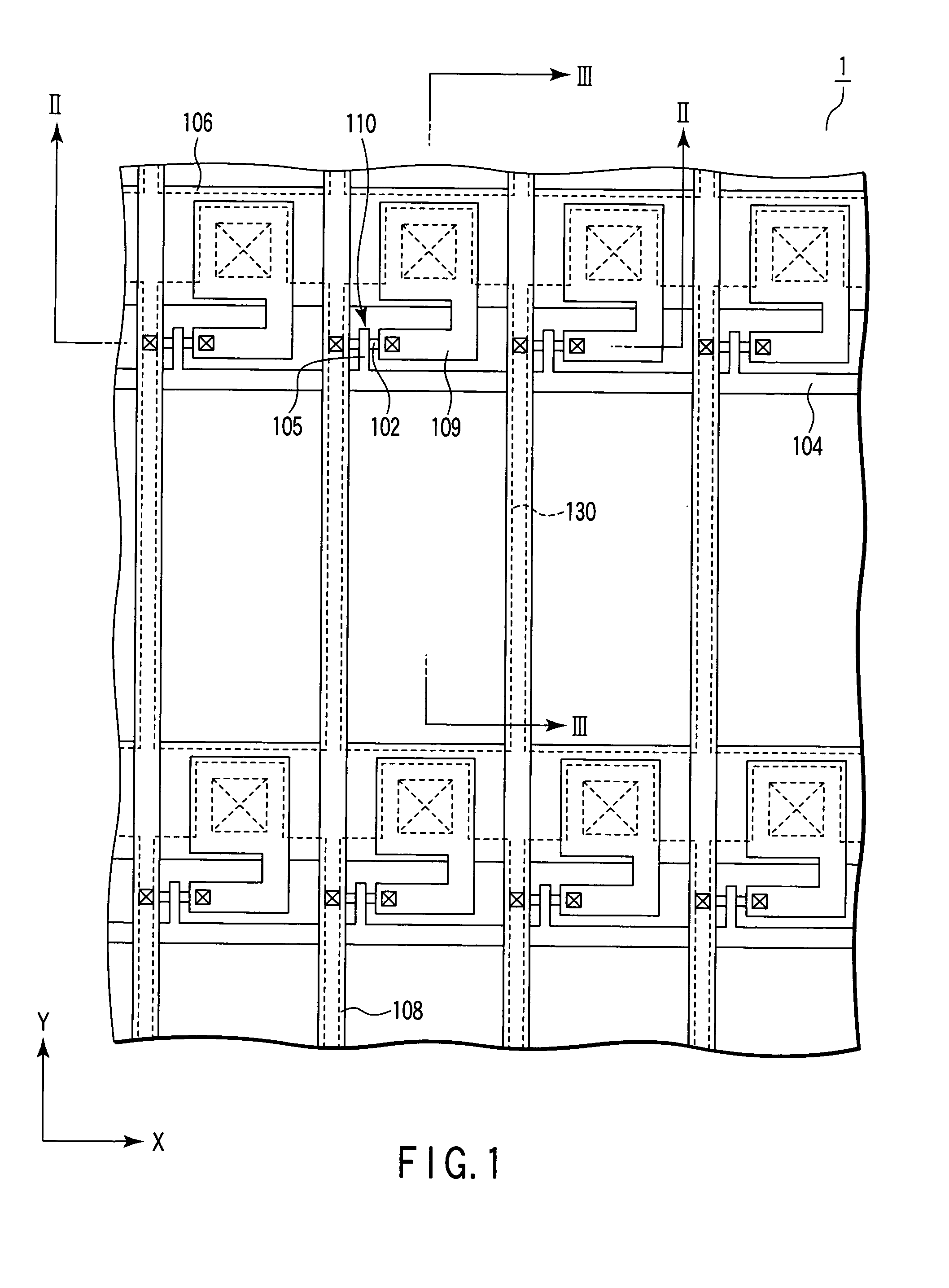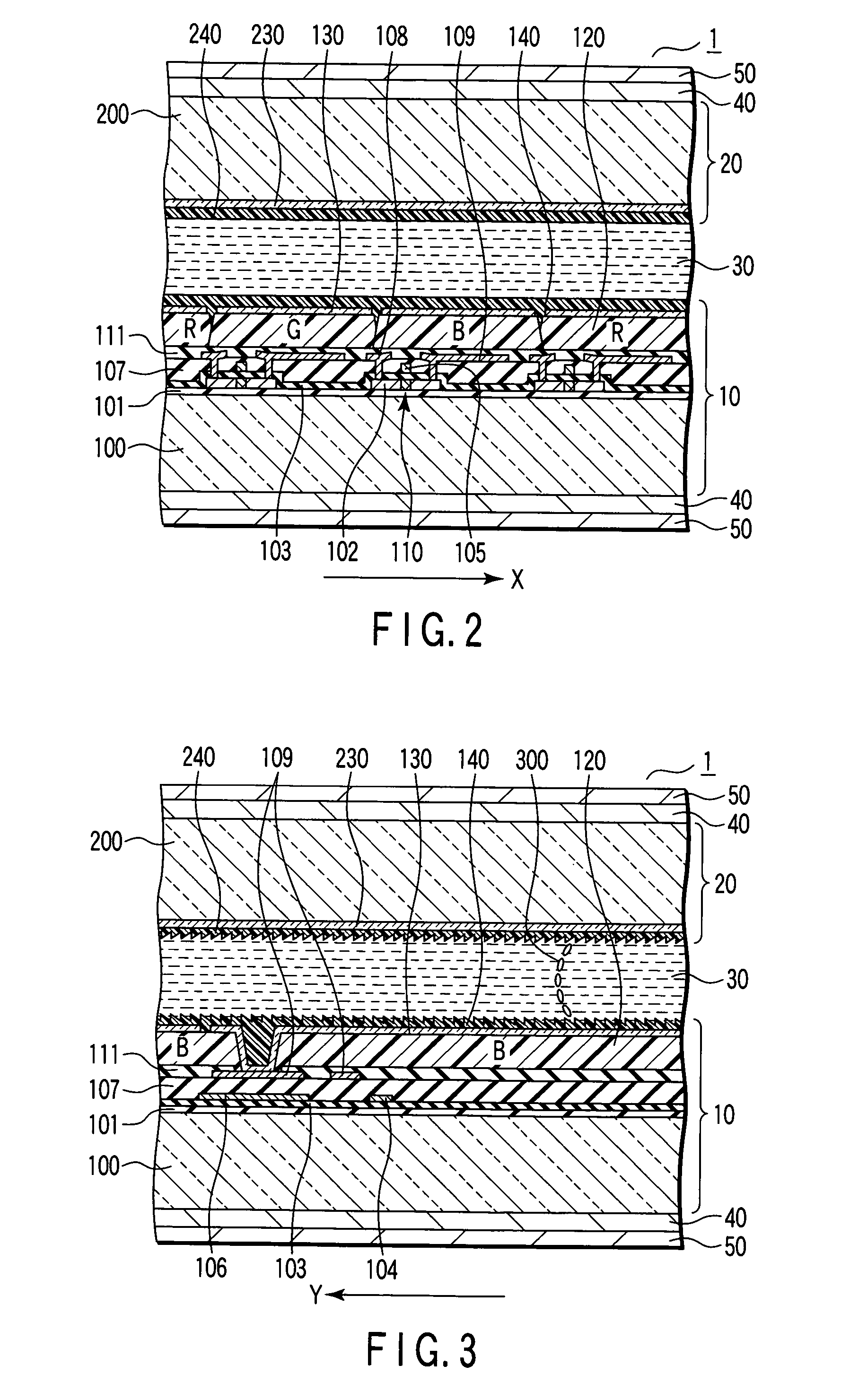Liquid crystal display
a liquid crystal display and display technology, applied in non-linear optics, instruments, optics, etc., can solve the problem of difficult stabilization of bend configuration
- Summary
- Abstract
- Description
- Claims
- Application Information
AI Technical Summary
Benefits of technology
Problems solved by technology
Method used
Image
Examples
example 1
[0166] In this example, the OCB-mode liquid crystal display shown in FIGS. 1 to 3 was manufactured by the following method. Note that the structure shown in FIG. 13 was used in this liquid crystal display, and the period P and inclination angle α of the alignment layers 140 and 240 were set at about 0.15 μm and 45°, respectively. In this example, the optical compensation film 40 was formed not on the outer surface of the back substrate 10, but only on the outer surface of the front substrate 20.
[0167] First, a structure from an undercoat layer 101 to pixel electrodes 130 was formed on a 0.5-mm-thick glass substrate 100. On this structure, an SiO2 layer and acrylic resin layer were sequentially formed as a planarizing layer 150. Also, a common electrode 230 was formed on a 0.5-mm-thick glass substrate 200.
[0168] Then, each of the planarizing layer 150 and common electrode 230 was spin-coated with Optomer-AL3456 manufactured by JSR, thereby forming a 0.8-μm-thick polyimide resin lay...
example 2
[0181] The liquid crystal display shown in FIGS. 1 to 3 was manufactured following the same procedures as explained in Example 1 except that the period P of each of the alignment layers 140 and 240 was set to about 0.25 μm.
[0182] In this example, the maximum value Dmax and minimum value Dmin Of the cell gap were about 8.0 μm and about 7.5 μm, respectively. Also, the maximum value RON−max of the optical retardation of the optical filter layer 30 in the on state was checked by using an ellipsometer, and found to be about 26 nm. That is, the maximum value Dmax, minimum value Dmin, and maximum value RON−max satisfy the relationship indicated by inequality (1). In addition, the maximum value εmjr of the relative dielectric constant of the liquid crystal material was about 19, and the relative dielectric constant εAL of the alignment layers 140 and 240 was about 4.0. Accordingly, the maximum value Dmax, minimum value Dmin, maximum value RON−max, maximum value εmjr, and relative dielectri...
example 3
[0185] In this example, the OCB-mode liquid crystal display shown in FIGS. 15 to 17 was manufactured by the following method. Note that in this liquid crystal display, the period P and inclination angle α of the alignment layers 140 and 240 were set to about 0.90 μm and 30°, respectively.
[0186] First, X electrodes 130 made of ITO were formed on a 0.5-mm-thick glass substrate 100. A planarizing layer 150 made of SiO2 was formed on this structure.
[0187] Also, a color filter 220 and Y electrodes 230 made of ITO were formed on a 0.5-mm-thick glass substrate 200. A planarizing layer 250 made of SiO2 was formed on this structure.
[0188] Then, 0.6-μm-thick inorganic insulating layers made of TaOx were formed on the planarizing layers 150 and 250. These inorganic insulating layers were obtained by forming films by RF sputtering using Ta2O5 as a sputter target, and annealing the films at 200° C. for 1 hour. At the same time these inorganic insulating layers were formed, another inorganic i...
PUM
| Property | Measurement | Unit |
|---|---|---|
| inclination angle | aaaaa | aaaaa |
| pretilt angle | aaaaa | aaaaa |
| pretilt angle | aaaaa | aaaaa |
Abstract
Description
Claims
Application Information
 Login to View More
Login to View More - R&D
- Intellectual Property
- Life Sciences
- Materials
- Tech Scout
- Unparalleled Data Quality
- Higher Quality Content
- 60% Fewer Hallucinations
Browse by: Latest US Patents, China's latest patents, Technical Efficacy Thesaurus, Application Domain, Technology Topic, Popular Technical Reports.
© 2025 PatSnap. All rights reserved.Legal|Privacy policy|Modern Slavery Act Transparency Statement|Sitemap|About US| Contact US: help@patsnap.com



